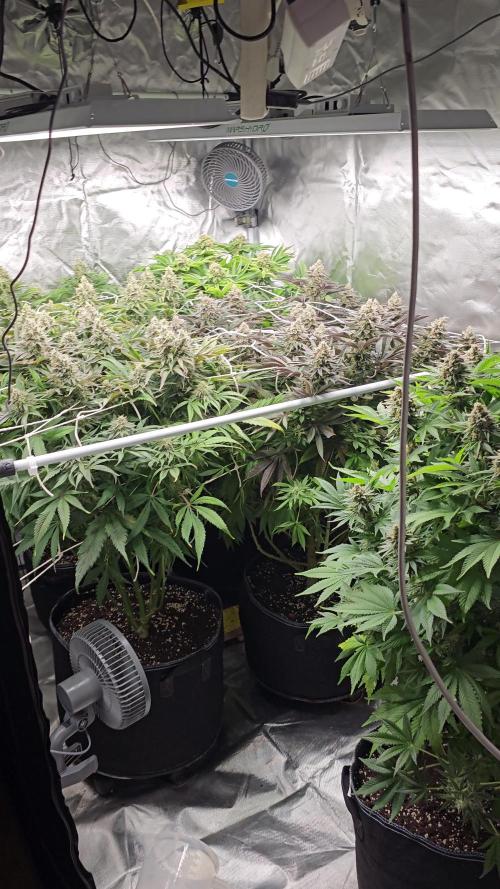The Grow Awards 2026 🏆 



































Likes
13
Share


@Silence
Follow
Ich denke, das wird die letzte Woche sein unter der Lampe
Tag 60 es wird Zeit für die Trockenzeit und 2 Tage Dunkelheit und dann wird geerntet.
Likes
9
Share


@AsNoriu
Follow
Day 122 since seed touched soil. Girl is on final stretch, took all nutes out last watering. Today gave 6.3 phed water for last time, maybe if few other girls will show signs of bulking, ill do one more watering.
Last week installed dehumidifier, so all environment is way better.
Fat girl, created nice colas and still bulking ...
Happy Growing !!!
Likes
10
Share


@CANNASIM
Follow
A lot of rain and wind, continuously. Temps have dropped as well.
I’m reading another week or two to chop this plants.
Sativa dominant hybrids did the best, the Fastberry and the banana purple punch did not really develop as the other two.
In specifics the cbd crack developed sizable buds, and the blue dream as well, the flowers are not as developed tight and dense as in the indoor grow. A bit of fox-tailing nothing too expressive.
Minimal work, as per the setup chosen, an no extra nutes this week.
Likes
49
Share


@Reyden
Follow
Ringrazio Seeds Mafia per avermi mandato questi semi sono veramente curioso di vedere come cresceranno! Gli ho tenuti tutti e tre per 2 ore a bagno in una soluzione di ormoni radicanti e acidi umici che poi ho messo diretto nel substrato…terriccio Biobizz light mix 🎥🌱💡
Likes
70
Share


@MrJones
Follow
Sky Walker
~~~~~INDOOR~~~~~
DAY 155 Above Dirt
💬Saturday 02.10.24 - Just watering every day and managing the environment, the buds continue to pack on weight and are starting to cause the flowers to leen, they are not huge but lots of golfball size hard rocks in there, and the smells are amazing, dank and earthy, with a fruit citrus funk, pretty damn nice!
📝 REAL GROWERS RECHARGE -is a mix-and-pour soil microbe superpack. It works like an instant compost tea. The soil microbes in Recharge go out and grab the nutrients in your soil, help break them down, and bring them back to your plant's root zone.
~~~~~~~~~~~~~~~
🌱Sky Walker
👨🌾Sativa Jones
🌤️@Medicgrow420
📝SeedBank Seeds
📝@gaiagreenorganics
📝Bokashi Biochar
📝Real Growers Recharge
📝 ProMix-HP
~~~~~~~~~~~~~~~
📝 Skywalker OG Strain is a top-shelf Indica dominant hybrid. It is a cross of Original Amsterdam Blueberry, OG Kush, and the indica strain Mazar from Afghanistan, and is best known for its super potent effects and sky-high THC levels.
Likes
4
Share


@Thomas12477
Follow
The plants are doing beautifully after two waves of bug attacks. The first wave was spider mites that I located in my greenhouse before they had a chance to spread to my canibus.I had to spray two days in a row to kill them all. Than 5 days layer I see thrips, so I gave it another spray. I foiler fead my nutrients.
Likes
63
Share


@AsNoriu
Follow
Day 126. She is down.
That girl lived 90 days from seed touching soil. Its part of my Control Garden for proving/finding RQS strain issue.
For 3 weeks veged bag seed plant who spent 75% of his life not under direct light, sometimes even in shade and under most intense air fan , she is GOLD !
Cure day. She could go two weeks longer, but ... 96 g ;))) again, i can only look and admire. Crazy strain. Update on night shift ;)
Likes
43
Share


@TheBulldozerSicily
Follow
Dopo 6 settimane di vegetativa per le nostre piccole talee, ormai velle grandi, arriva il momento in andare in fioritura e continuare a crescere e fiorire!!.
Seguiranno aggiornamenti.
Martedì 20/02/2024
Inizio controllo 2027 ec 5.5 ph
Cambiamo soluzione e iniziamo con i nuovo dosaggi da prefioritura
Aggiungiamo 75 lt demineralizzata
Base 285 ec 7 ph
Aggiungiamo i nutrienti per 80 lt
160 grow 160 micro 120 bloom
90 sensizym 90 calmag 90 rhino skin 90 bud candy
Otteniamo 2146 ec 6.3 ph
Aumentino al 100% la nostra mars hydro fc6500 e la teniamo a 40 cm di distanza.
Likes
13
Share


@StickyFingah420
Follow
Planta hermosa, de estructura resistente y cogollos rocosos y repletos de resina.
Resistente bien el entrenamiento LST y topping, pide bastante alimentos y te recomiendo lavar bien las raíces antes de cosechar si has usado fertilizantes.
Los frutos desprenden una fragancia exquisita y muy dulce.
Likes
10
Share


@InnerCityGardens
Follow
Week 14, looking good. Just trying to keep an even canopy, and upping the feed as and when needed 🙌🏽💚
Likes
43
Share


@OntarioBigGreen
Follow
After last week crazy heat wave that stop the growth....everything is back growing almost 2” per day...Thc #1 is now standing at 87”( yes 7’ and 4” ( what a beauty) #2 is at 74 “ ...but the pests and pest are on my girls( mealy bugs ,lots of aphids and fews inch worm) ,the soap did not work so add to take drastic measures “pesticide “ I used end-all with a very fine mist and I remove lots of leaf to give more lighting inside ( even not been a fan of defoliation sometimes you need to do ) now still see fews little aphids under leafs but nothing crazy ( so I spent lots of time everyday checking new growth and under leafs to squeeze thems and I put bunch of glue stick for bugs hoping this will held me little more) .looked like the have started flowering so I’ll do one more veg fertilizer but I’ll cut
in half the strength and won’t put rapid stater as I want her to started thinking flowers and next week onto flower juice😃...
Bombseeds you guys have amazing genetics 😍
Likes
Comments
Share


@MrEarlyBird
Follow
Water only from here on out. Final stretch and last week before harvest. This one was fun :’)
Likes
11
Share


@Nenodiflowers
Follow
Birşeyler ters gitti istedigim verimi alamadım ama trichomeler çok iyi gelişti
Likes
10
Share


@Bud_vista
Follow
Welcome to week 7!
She’s doing great in her second week of flowering!
She is still stretching and got a bigger defoliation at the end of week 6.
For the start she’s getting only ph regulated water from top and some nutrients from bottom. There a little signs on the leaf tip why I skip nutrients for one watering cycle.
On mid of week 7 she’s still stretching and first orange pistils shown up. On weekend she’s getting another defloration and another round of nutrients.
We are finishing week 7 shortly! She was defoliated once again to ensure more light density in lower conopy. She’s doing still great and she’s not showing any signs of stress or leak of nutrients. It seems that she’s also stopped stretching. Looking forward to the next weeks!
Likes
24
Share


@TerpTurtle
Follow
Strawberry Truffle - White Truffle x Red Pop & limited seed it came with Chem 91 x Red pop
Likes
29
Share


@GrownwithLED
Follow
After week 16 of this grow my 'Fruity Terps'-plants are ready to harvest. I check the trichome-heads with a handheld-microscope (magnification of 150, available in every growshop) and see that all have turned milky and some start to turn amber already. That means PEAK-THC (=all trichome-heads have turned milky) has been reached inside the trichome and it is time to harvest. If I would let them go longer now and continue to flower them, more of the trichome heads will turn amber as the THC breaks down again to other cannabinoids, and the effect of the cannabis will get more sedative when smoked. For some chronic pain patients this is what they want from their medicine, therefore it is advisable for them to let the weed flower than recommended.
The aroma coming out of the tent is STRONG and DELICIOUSLY FRUITY! 😍 The fade from the flush has turned the bigger fan-leaves yellow or purple now, this shows the plant is using her own sugars now and has used up all nutrients saved inside her. That is exactly what I want, since a well flushed plant ensures a clean, smooth smoke when the buds are dried. This is my MEDICINE and I use it against my chranic back-pain from hernia, therefore I have to make sure I can consume my medicine as pure and clean as possible.
All my plants have grown big buds, which are glistening with TRICHOMES, the SANlight EVO4-120 LEDs did an OUTSTANDING JOB! In combination with the BIO NOVA nutrients, all plants THRIVED throughout the cycle and were able to grow healthy to their full potential.
Likes
16
Share

@Shawneyboy85
Follow
This week the smell have really developed and the pistols are long gone but she’s plumping up! This one is only 63 days old and shows a lot of ruderalis in the fans but I’m happy how the bud structure is forming and would recommend anyone else that grows this to top it and scrog it for sire cuz she’s going to stretch a lot she’s 38 inches tall.
Likes
283
Share


@love_2_grow
Follow
FD36 - True to form I completely forgot to take any pics before the lights were out. The third week in a row. I'm detecting a pattern... lol
FD37 - Pics!
FD38 - Today, I was proactive in trying to prevent botrytis (budrot) since I have had problems in the past when temperatures and humidity get too high in late flower.
I started with defoliating hard by removing fan leaves. That should lower the humidity in the tent as there are fewer leaves to transpire moisture, and also increase the airflow around the buds.
Finally, I put my small humidifier in the tent to further lower the humidity.
FD41 - The anti-humidity measures are working. The tent went from an average RH in the high 60s to the high 40s. (The average RH in the last 24 hours was 48.9%.) I'm happy with that, which should be enough to avoid budrot. Better safe than sorry, so I did additional LST to open up the plants and thus increase the airflow around the buds. It's also helpful to increase light penetration, so win-win.
FD42 - We're at the end of the sixth week of flower, and things are chugging along in the tent. The buds are slowly fattening up, but it will take some time before they are done.
There isn't much to do in the tent this late in flower besides watering. Today, each girl got 2.5-liters of water @ pH 6.5.




















